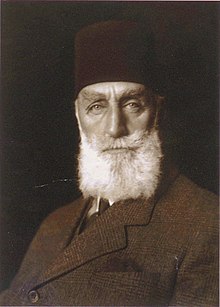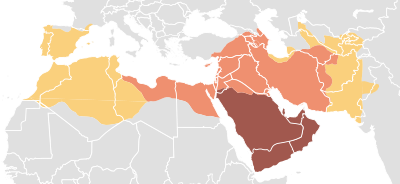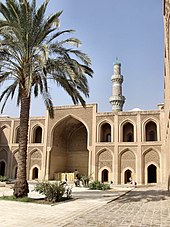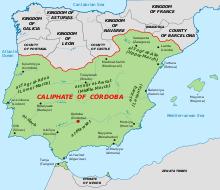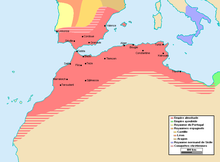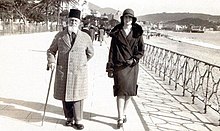Caliphate
The term caliphate (in Arabic: Equatorial Guinea, فة, phonetic transliteration to Spanish: JalifaArabic phonetic transliteration: Khalifa(pronounced) [χalifæ](![]() listen) lit: succession) was initially led by the disciples of Mohammed as a continuation of the religious system established by the Prophet known as 'Califatos de Rashidun'. A caliphate is also a
State that implements this type of political system.
listen) lit: succession) was initially led by the disciples of Mohammed as a continuation of the religious system established by the Prophet known as 'Califatos de Rashidun'. A caliphate is also a
State that implements this type of political system.
The Sunni branch of Islam stipulates that, as head of state, a caliph must be chosen by Muslims or their representatives. Followers of Shia Islam, however, believe that a caliph must be an Imam chosen by God from Ahl al-Bayt (the 'Family of the House', the direct descendants of Muhammad). In simpler terms, the Sunni majority favors elections, while the Shia minority prefers bloodline.
Caliphates of Islam
The following caliphates arose or were created:
- Continue
- Four Orthodox Caliphs (632-661). Elected by the community. Unique caliphate recognized by Sunni and Shia. His capital was Medina.
- Omeya Caliphate (661-756). First hereditary caliphate of Sunni orientation. His capital was Damascus.
- Abbasid Caliphate (756-1517). Sunni orientation. His capital was Kufa (756-762), then Baghdad (762-1258) and finally Cairo (1258-1517).
- Ottoman Caliphate (1517-1924). Sunni orientation. His capital was Istanbul. Turkey abolished the caliphate in the constitutional reform of 1926.
- «Rebels» or independent
- Caliphate Fatimí (909-1171). Chií orientation. Its capitals were Kairouan (909-973) and Cairo (973-1171).
- Caliphate Omeya de Córdoba (929-1031). Of Sunni orientation founded by Abderramán I of the Omeya family when fleeing to Spain after the Abbasid Revolution, naturally not recognized by the Abbasid Caliphate. In 929 Abderraman III is proclaimed prince of believers.
- Sokoto Caliphate (1809-1903). From Sunni orientation and created in Africa by the fulani ethnicity in the context of the fulani jihads.
In addition, the Almohad Empire (1145-1269), with its capital in Marrakesh, although it was not officially a caliphate nor did its ruler use the title of caliph, did use a title usually associated with the caliph: that of prince of the believers (later inherited by the sultan of Morocco, until today).
On the other hand, Husayn ibn Ali, Sherif of Mecca, after the fall of the Ottoman Empire and in the midst of the debates that swept through the Islamic world about the recovery of the recently abolished caliphate, used for a few years, until his death, the title of caliph. The caliph was also the highest authority of the Islamic empire.
History
Rashidun Caliphate (632-661)
Succession to Muhammad
Immediately after Muhammad's death, a meeting of the Ansar (natives of Medina) took place in the Saqifah (courtyard) of the Banu Sa'ida clan. the time was that the purpose of the meeting was for the Ansar to decide among themselves a new leader of the Muslim Community, with the intentional exclusion of the Muhajirun (migrants from Mecca), although this has subsequently been the subject of debate.
However, Abu Bakr and Umar, both prominent companions of Muhammad, upon learning of the meeting, became concerned about a possible coup and rushed to it. Upon arrival, Abu Bakr addressed the assembled warning that an attempt to elect a leader who did not belong to Muhammad's own tribe, the Quraysh, was likely to lead to dissension, as only they could command the necessary respect among the people. community. So he took Umar and another companion, Abu Ubaidah ibn al-Jarrah, by the hand and offered them to the Ansar as possible options. He was answered with the suggestion that the Quraysh and the Ansar elect one leader each, who would rule jointly. The group got heated upon hearing this proposal and started arguing among themselves. Umar hastened to take Abu Bakr's hand and pledge his own allegiance to him, an example followed by the assembled men.
Abu Bakr was almost universally accepted as head of the Muslim community (under the title of Caliph) as a result of Saqifah, though he faced contention as a result of the precipitous nature of the event. Several companions, most notably Ali ibn Abi Talib, initially refused to acknowledge his authority, Ali may have been reasonably expected to assume leadership, being both Muhammad's cousin and son-in-law. The theologian Ibrahim al-Nakha'i stated that Ali also had the support of the Ansar for his succession, which was explained by the genealogical ties he shared with them. It is unknown whether his succession bid was raised during the Saqifah, although it is not unlikely.Abu Bakr later sent Umar to confront Ali to win his allegiance, leading to an altercation that may have involved violence. However, after six months the group made peace with Abu Bakr and Ali offered his allegiance.
Rāshidun Caliphs
Abu Bakr named Umar as his successor on his deathbed. Umar, the second caliph, was killed by a Persian slave named Abu Lu'lu'a Firuz. His successor, Uthman, was chosen by a council of electors (majlis). Uthman was killed by members of a disaffected group. Ali then took control, but was not universally accepted as caliph by the governors of Egypt and, later, by some of his own guard. He faced two major rebellions and was assassinated by Abd-al-Rahman ibn Muljam, a Jawarij. Ali's tumultuous rule lasted only five years. This period is known as the Fitna, or the first Islamic civil war. Ali's followers later became the Shiites ('shiaat Ali', supporters of Ali.) a minority sect of Islam and reject the legitimacy of the first 3 caliphs. The followers of the four Rāshidun caliphs (Abu Bakr, Umar, Uthman and Ali) became the majority Sunni sect.
Under the Rāshidun each region (Sultanate, Wilayah, or Emirate) of the Caliphate had its own governor (Sultan, Wāli, or Emir). Muāwiyah, a relative of Uthman and governor (Wali) of Syria, succeeded Ali as caliph. Muāwiyah made the caliphate a hereditary office, thus founding the Umayyad dynasty.
In areas formerly under the rule of the Sasanian or Byzantine Empires, the caliphs reduced taxes, provided greater local autonomy (for their deputy governors), greater religious freedom for Jews and some indigenous Christians, and they brought peace to peoples demoralized and challenged by casualties and heavy taxation resulting from decades of Byzantine-Persian War.
The Caliphate of Ali, Hasan and the rise of the Umayyad dynasty
Ali's reign was plagued by turmoil and infighting. The Persians, taking advantage of this, infiltrated the two armies and attacked the other army causing chaos and internal hatred among Muhammad's companions at the Battle of Siffin. The battle lasted several months, resulting in a draw. To avoid further bloodshed, Ali agreed to negotiate with Mu'awiyah. This caused a faction of approximately 4,000 people, which would come to be known as the Kharijites, to give up the fight. After defeating the Kharijites in the Battle of Nahrawan, Ali was later assassinated by the Kharijite Ibn Muljam. Ali's son Hasan was chosen as the next caliph, but abdicated in favor of Mu'awiyah a few months later to avoid any conflict within the Muslims. Mu'awiyah became the sixth caliph, establishing the Umayyad dynasty, named after Uthman and Mu'awiyah's great-grandfather, Umayya ibn Abd Shams.
Umayyad Caliphate (661-750)
From the Umayyads, the title of caliph became hereditary. Under the Umayyads, the territory of the caliphate expanded rapidly, incorporating the Caucasus, Transoxiana, Sindh, the Maghreb and a large part of the Iberian Peninsula (Al-Andalus) to the Muslim world. At its largest, the Umayyad Caliphate spanned 13,400,000 km2, making it the largest empire in the world and the sixth largest in history.
Geographically, the empire was divided into several provinces, whose borders changed several times during the Umayyad reign. Each province had a governor appointed by the caliph. However, for a variety of reasons, including not being chosen by the Shura and suggestions of impious behavior, the Umayyad dynasty was not universally supported within the Muslim community. Some supported prominent early Muslims like Zubayr ibn al-Awwam; others felt that only members of Muhammad's clan, the Banu Hashim, or his own lineage, the descendants of Ali, should rule.
There were numerous rebellions against the Umayyads, as well as splits within Umayyad ranks (particularly the rivalry between the Yaman and Qays tribes). Under the command of Yazid son of Muawiya, an army led by Umar ibn Saad, a commander by the name of Shimr ibn Thil-Jawshan killed Ali Hussein's son and his family at the Battle of Karbala in 680, solidifying relations. Shia-Sunni. Eventually, supporters of the Banu Hashim and supporters of Ali's lineage united to overthrow the Umayyads in 750. However, the Shi'at 'Alī, & 'Ali's Party', were again disappointed when the Abbasid dynasty took power, as the Abbasids were descended from Muhammad's uncle 'Abbas ibn 'Abd al-Muttalib and not from there.
Abbasid Caliphate (750-1517)
Abbasid Caliphs in Baghdad
In the year 750, the Umayyad dynasty was overthrown by another family of mechanical origin, the Abbasids. His time represented a scientific, cultural and religious flowering. Islamic art and music also flourished significantly during his reign. The main city and capital of he Baghdad began to flourish as a center of knowledge, culture and commerce. This period of cultural flourishing ended in 1258 with the sack of Baghdad by the Mongols under Hulagu Khan. However, the Abbasid Caliphate had already lost its effective power outside of Iraq by 920. By 945, the loss of power became official when the Buyids conquered Baghdad and all of Iraq. The empire fell apart and its parts were ruled for the next century by local dynasties.
In the 9th century century, the Abbasids created an army loyal only to their caliphate, composed predominantly of Turkish slaves of Turkish origin. Cuman, Circassian and Georgian, known as Mamluks. Around 1250 the Mamluks came to power in Egypt. The Mamluk army, though often viewed in a negative light, helped and hurt the caliphate. At first, it provided the government with a stable force to deal with internal and external problems. However, the creation of this foreign army and the transfer of the capital from Baghdad to Samarra by al-Mu'tasim created a division between the caliphate and the peoples they claimed to rule. Furthermore, the power of the Mamluks did not stop growing until Ar-Radi (934-41) was forced to cede most of the royal functions to Muhammad ibn Ra'iq.
Under the Mamluk Sultanate of Cairo (1261-1517)
In 1261, following the Mongol conquest of Baghdad, the Mamluk rulers of Egypt attempted to gain legitimacy for their rule by declaring the reestablishment of the Abbasid Caliphate in Cairo. The Abbasid caliphs in Egypt had little political power; they continued to hold the symbols of authority, but their domain was limited to religious affairs.[citation needed] The first Abbasid Caliph of Cairo was Al-Mustansir (r. June -November 1261). The Abbasid Caliphate of Cairo lasted until the time of Al-Mutawakkil III, who ruled as caliph from 1508 to 1516, then was briefly deposed in 1516 by his predecessor Al-Mustamsik, but was restored to caliphate again in 1517..
The Ottoman Grand Sultan Selim I defeated the Mamluk Sultanate and made Egypt part of the Ottoman Empire in 1517. Al-Mutawakkil III was captured along with his family and transported to Constantinople as a prisoner, where he played a ceremonial role. He died in 1543, upon his return to Cairo.
Parallel regional caliphates in late Abbasid times
The Abbasid dynasty lost effective power over much of the Muslim kingdom in the first half of the X century.
The Umayyad dynasty, which had survived and come to rule over Al-Andalus, claimed the title of caliph in 929, lasting until its overthrow in 1031.
Umayyad Caliphate of Córdoba (929-1031)
During the Umayyad dynasty, the Iberian Peninsula was a province that was part of the Umayyad Caliphate that ruled from Damascus. The Umayyads lost the position of caliph in Damascus in 750, and Abd al-Rahman I became emir of Córdoba in 756 after six years of exile. Intent on regaining power, he defeated the area's Islamic rulers who were challenging Umayyad rule and united several local fiefdoms into an emirate.
The rulers of the emirate used the title "emir" or "sultan" until the X century, when Abd al-Rahman III faced the threat of invasion by the Fatimid Caliphate. To aid his fight against the invading Fatimids, who were claiming the caliphate in opposition to the generally recognized Abbasid Caliph of Baghdad, Al-Mu'tadid, Abd al-Rahman III claimed the title of caliph himself. This helped Abd al-Rahman III gain prestige among his subjects, and the title was retained after the Fatimids were repulsed. The rule of the caliphate is considered the heyday of the Muslim presence in the Iberian Peninsula, before it fragmented into various taifas in the 11th century. This period was characterized by the flourishing of technology, commerce and culture; many of the buildings in al-Andalus were built at this time.
Almohad Caliphate (1147-1269)
The Almohad Caliphate (in Berber languages, Imweḥḥden, from Arabic الموحدون al-Muwaḥḥidun, "the monotheists" or "the unifiers") was a Moroccan Berber Muslim movement founded in the XII.
The Almohad movement was started by Ibn Tumart among the Masmuda tribes of southern Morocco. The Almohads first established a Berber state at Tinmel in the Atlas Mountains in about 1120. The Almohads succeeded in overthrowing the Almoravid dynasty in ruling Morocco in 1147, when Abd al-Mu'min (r. 1130 -1163) conquered Marrakech and declared himself caliph. He then extended his power throughout the Maghreb in 1159. Al-Andalus followed the fate of Africa and all of Islamic Iberia was under Almohad rule by 1172.
Almohad rule of Iberia continued until 1212, when Muhammad al-Nasir (1199-1214) was defeated at the Battle of Las Navas de Tolosa in the Sierra Morena by an alliance of the Christian princes of Castile, Aragon, Navarre, and Portugal. Almost all of the Moorish domains in Iberia were lost soon after, with the great Moorish cities of Córdoba and Seville falling to the Christians in 1236 and 1248, respectively.
The Almohads continued to rule North Africa until the gradual loss of territory due to the revolt of tribes and districts allowed the rise of their most effective enemies, the Marinid dynasty, in 1215.[quote required] The last representative of the line, Idris al-Wathiq, was reduced to possession of Marrakech, where he was murdered by a slave in 1269; the Merinids seized Marrakesh, ending Almohad rule of the Western Maghreb.
Fatimid Caliphate (909-1171)
The Fatimid Caliphate was a Shia Ismaili caliphate, originally based in Tunisia, which extended its rule along the Mediterranean coast of Africa, eventually making Egypt the center of its caliphate. At its height, in addition to Egypt, the caliphate included various areas of the Maghreb, Sicily, the Levant and the Hijaz.
The Fatimids established the Tunisian city of Mahdia and made it their capital, before conquering Egypt and building the city of Cairo there in 969. From then on, Cairo became the capital of the caliphate and Egypt the the political, cultural and religious center of the State. The Islamic scholar Louis Massignon called the century the IV / X of the Christian era as the "century of Ismailism" in the history of Islam".
The term Fatimid is sometimes used to refer to the citizens of this caliphate. The state's ruling elite belonged to the Ismaili branch of Shi'ism. The leaders of the dynasty were Ismaili imams and they had religious significance for Ismaili Muslims. They are also part of the chain of holders of the office of caliph, as recognized by some Muslims. Thus, this is a rare period in history in which the descendants of Ali (hence the name Fatimids, referring to Ali's wife Fatima) and the caliphate were united to some degree, except for the period end of the Rashidun Caliphate under Ali himself.
The caliphate was reputed to exercise a degree of religious tolerance towards non-Ismaili sects of Islam, as well as Jews, Maltese Christians and Copts.
The Shiʻa Ubayd Allah al-Mahdi Billah of the Fatimid Dynasty, who claimed descent from Muhammad through his daughter, claimed the title of caliph in 909, creating a separate line of caliphs in North Africa. The Fatimid caliphs, who originally controlled Algeria, Tunisia and Libya, extended their rule over the next 150 years, taking Egypt and Palestine, before the Abbasid dynasty managed to turn the tables, limiting Fatimid rule to Egypt. The Fatimid dynasty finally ended in 1171 and was overtaken by Saladin of the Ayyubid dynasty.
Ayyubid Caliphate (1171-1260)
The Ayyubid Empire surpassed the Fatimids by incorporating the empire into the Abbasid Caliphate. However, Saladin himself has been a celebrated caliph in Islamic history.
Ottoman Caliphate (1517-1924)
The caliphate was claimed by the sultans of the Ottoman Empire beginning with Murad I (reigned 1362-1389), while acknowledging no authority from the Abbasid caliphs of Mamluk-ruled Cairo. Hence the seat of the caliphate was moved to the Ottoman capital of Edirne. In 1453, after Mehmed the Conqueror's conquest of Constantinople, the Ottoman headquarters moved to Constantinople, present-day Istanbul. In 1517, the Ottoman Sultan Selim I defeated and annexed the Mamluk Sultanate of Cairo to his empire. Through the conquest and unification of the Muslim lands, Selim I became the defender of the Holy Cities of Mecca and Medina., which further strengthened the Ottoman claim to the caliphate in the Muslim world. The Ottomans gradually came to be regarded as the de facto leaders and representatives of the Islamic world. However, the early Ottoman caliphs did not officially bear the title of caliph on their state documents, inscriptions, or coins. Only at the end of the century The 18th century sultans found the caliphate claim to have practical utility, as it allowed them to counteract Russian claims to protect Ottoman Christians with their own claim to protect Muslims under Russian rule.
The outcome of the Russo-Turkish War of 1768-1774 was disastrous for the Ottomans. Large territories, including those with large Muslim populations, such as Crimea, were lost to the Russian Empire. However, the Ottomans under Abdul Hamid I claimed a diplomatic victory by being allowed to remain the religious leaders of Muslims in the now independent Crimea. as part of the peace treaty; in return, Russia became the official protector of Christians in Ottoman territory. According to Barthold, the first time the Ottomans used the title "caliph" as a political rather than religious symbolic title was in the Treaty of Küçük Kaynarca with the Russian Empire in 1774, when the Empire retained moral authority in the territory whose sovereignty was ceded to the Russian Empire.
The British supported and propagated the view that the Ottomans were caliphs of Islam among the Muslims of British India, and the Ottoman sultans helped the British by issuing pronouncements to the Muslims of India telling them to support the British rule of Sultan Ali. III and Sultan Abdülmecid I.
Circa 1880, Sultan Abdul Hamid II reasserted the title as a way of countering Russian expansion into Muslim lands. The claim to him was accepted with greater fervor by the Muslims of British India. On the eve of World War I, the Ottoman state, despite its weakness in relation to Europe, represented the largest and most powerful independent Islamic political entity. The sultan also enjoyed some authority beyond the borders of his small empire as caliph of the Muslims in Egypt, India, and Central Asia.
In 1899 John Hay, Secretary of State, asked the American ambassador to Ottoman Turkey, Oscar Straus, to approach Sultan Abdul Hamid II to use his position as caliph to command the Tausūg people of the Sulu Sultanate in the Philippines to submit to US sovereignty and the military government of that country; the sultan complied and wrote the letter which was sent to Sulu via Mecca. As a result, the "Sulu Mohammedans...refused to join the insurgents and placed themselves under the control of our military, thus acknowledging American sovereignty"."
Abolition of the Caliphate (1924)
After the Mudros Armistice of October 1918 with the military occupation of Constantinople and the Treaty of Versailles (1919), the position of the Ottomans was uncertain. The movement to protect or restore the Ottomans gained momentum after the Treaty of Sèvres (August 1920), which forced the partition of the Ottoman Empire and gave Greece a powerful position in Anatolia, much to the dismay of the Turks. They asked for help and the movement was the result. The movement collapsed at the end of 1922.
On March 3, 1924, the first president of the Turkish Republic, Mustafa Kemal Atatürk, as part of his reforms, constitutionally abolished the institution of the caliphate. Atatürk offered the caliphate to Ahmed Sharif as-Senussi, on the condition that he reside outside of Turkey; Senussi declined the offer and confirmed his support for Abdulmejid. The title was then claimed by Hussein bin Ali, Sharif of Mecca and Hejaz, leader of the Arab Revolt, but his kingdom was defeated and annexed by ibn Saud in 1925.
Egyptian scholar Ali Abdel Raziq published his book Islam and the Foundations of Government in 1925. The argument of this book has been summarized as "Islam does not advocate a specific form of government". He focused his criticism both on those who use religious law as a contemporary political proscription and on the history of the rulers. who claim the legitimacy of the caliphate. Raziq wrote that past rulers spread the notion of the caliphate's religious justification "so that they could use religion as a protective shield for their thrones against rebel attacks".
In 1926 a summit was convened in Cairo to discuss the revival of the caliphate, but most Muslim countries did not participate and no action was taken to implement the summit resolutions. Although the title Ameer al-Mumineen was adopted by the King of Morocco and by Mohammed Omar, a former head of the Taliban in Afghanistan, neither claimed any legal position or authority over Muslims outside of the borders of their respective countries.[citation needed]
Since the end of the Ottoman Empire, there have been occasional demonstrations calling for the re-establishment of the caliphate. Organizations calling for the reinstatement of the caliphate include Hizb ut-Tahrir and the Muslim Brotherhood.
Regional caliphates parallel to the Ottomans
Indian Subcontinent
Following the Umayyad campaigns in India and the conquest of small territories in the western part of the Indian peninsula, the first Indian Muslim dynasties were founded by the Ghurid dynasty and the Ghaznavids, most notably the Delhi Sultanate. The Indian sultanates did not put much effort into achieving a caliphate, as the Ottoman Empire already observed the caliphate. Although the Mughal Empire is not recognized as a caliphate, its sixth emperor Muhammad Alamgir Aurangzeb has often been regarded as one of the few Islamic caliphs who have ruled the Indian peninsula. He received the support of Ottoman sultans such as Suleiman II and Mehmed IV. As a Quran memorizer, Aurangzeb fully established Sharia in South Asia through his Fatawa 'Alamgiri. He reintroduced the jizya and prohibited Islamically illicit activities. However, Aurangzeb's personal expenses were covered by his own income, which included sewing caps and trading in his written copies of the Qur'an. For this reason, he has been compared to the second caliph Umar bin Khattab and the Kurdish conqueror Saladin. Other notable rulers include Muhammad bin Bakhtiyar Khalji, Alauddin Khilji, Firuz Shah Tughlaq, Shamsuddin Ilyas Shah, Babur, Sher Shah Suri, Nasir I of Kalat, Tipu Sultan, and the Nawabs of Bengal were popularly given the term Khalifa.
Bornu Caliphate (1472-1893)
The Bornu Caliphate, headed by the Bornu emperors, began in 1472. Its rulers, who were a state of most of the Kanem-Bornu Empire, held the title of caliph until 1893, when it was absorbed into the Colony British Nigeria and the North Cameroons Protectorate. The British recognized them as 'Sultans of Bornu', one step below Muslim royal titles. After Nigeria's independence, its rulers became the "Amirs of Bornu", another step up.
Yogyakarta Caliphate (1755-2015)
The Indonesian Sultan of Yogyakarta historically used Khalifatullah (Caliph of God) as one of his many titles. In 2015 Sultan Hamengkubuwono X renounced any claim to a caliphate to make it easier for his daughter to inherit the throne, as the theological view at the time was that a woman can hold the secular position of sultan but not the spiritual one of caliph.
Sokoto Caliphate (1804-1903)
The Sokoto Caliphate was an Islamic state in present-day Nigeria led by Usman dan Fodio. Founded during the Fulani War in the early 19th century, it controlled one of the most powerful empires in sub-Saharan Africa before the European conquest and colonization. The caliphate continued to exist during the colonial period and afterwards, albeit with reduced power. The current head of the Sokoto Caliphate is Sa'adu Abubakar.
Toucouleur Empire (1848-1893)
The Toucouleur Empire, also known as the Tukular Empire, was one of the Fulani jihad states in sub-Saharan Africa. It was eventually pacified and annexed by the French Republic, being incorporated into French West Africa.
Khilafat Movement (1919-1924)
The Khilafat Movement was launched by Muslims in British India in 1920 to defend the Ottoman Caliphate at the end of World War I and spread throughout British colonial territories. It was strong in British India, where it was a rallying point for some Indian Muslims as one of many anti-British Indian political movements. Among its leaders were Mohammad Ali Jouhar, his brother Shawkat Ali and Abul Kalam Azad, Dr. Mukhtar Ahmed Ansari, Hakim Ajmal Khan and the lawyer Muhammad Jan Abbasi. For a time it was supported by Mohandas Karamchand Gandhi, who was a member of the Khilafat Central Committee. However, the movement lost its momentum after the abolition of the Caliphate in 1924. Following further arrests and the flight of its leaders, and After a series of splinter offshoots of the main organization, the Movement eventually died out and dissolved.
Sharifian Caliphate (1924-25)
The Sharifian Caliphate (Arabic: خلافة شريفية) was an Arab caliphate proclaimed by the Sharifian rulers of the Kingdom of Hejaz in 1924 formerly known as Vilayet Hejaz, declaring independence from the Ottoman Caliphate. The idea of the Sharifian Caliphate had been floating around since at least the 15th century. -variant:small-caps;text-transform:lowercase">XIX, began to gain importance due to the decline of the Ottoman Empire, which was heavily defeated in the Russo-Turkish War of 1877-78. However, there is little evidence that the idea of a Sharifian caliphate ever gained wide popular support in the Middle East or elsewhere in the Muslim world.
Disputes
In 2014 Abu Bakr al-Baghdadi on behalf of the Islamic State of Iraq and the Levant announced a self-proclaimed caliphate. Its supposed capital was Al Raqa from 2014 until on October 17, 2017, the Syrian Democratic Forces took full control of the city. On March 23, 2019, the US and Kurdish forces announce the end of the Islamic State caliphate in Syria.
Contenido relacionado
Alessandro Volta
Russian painting
Spanish subgroup
